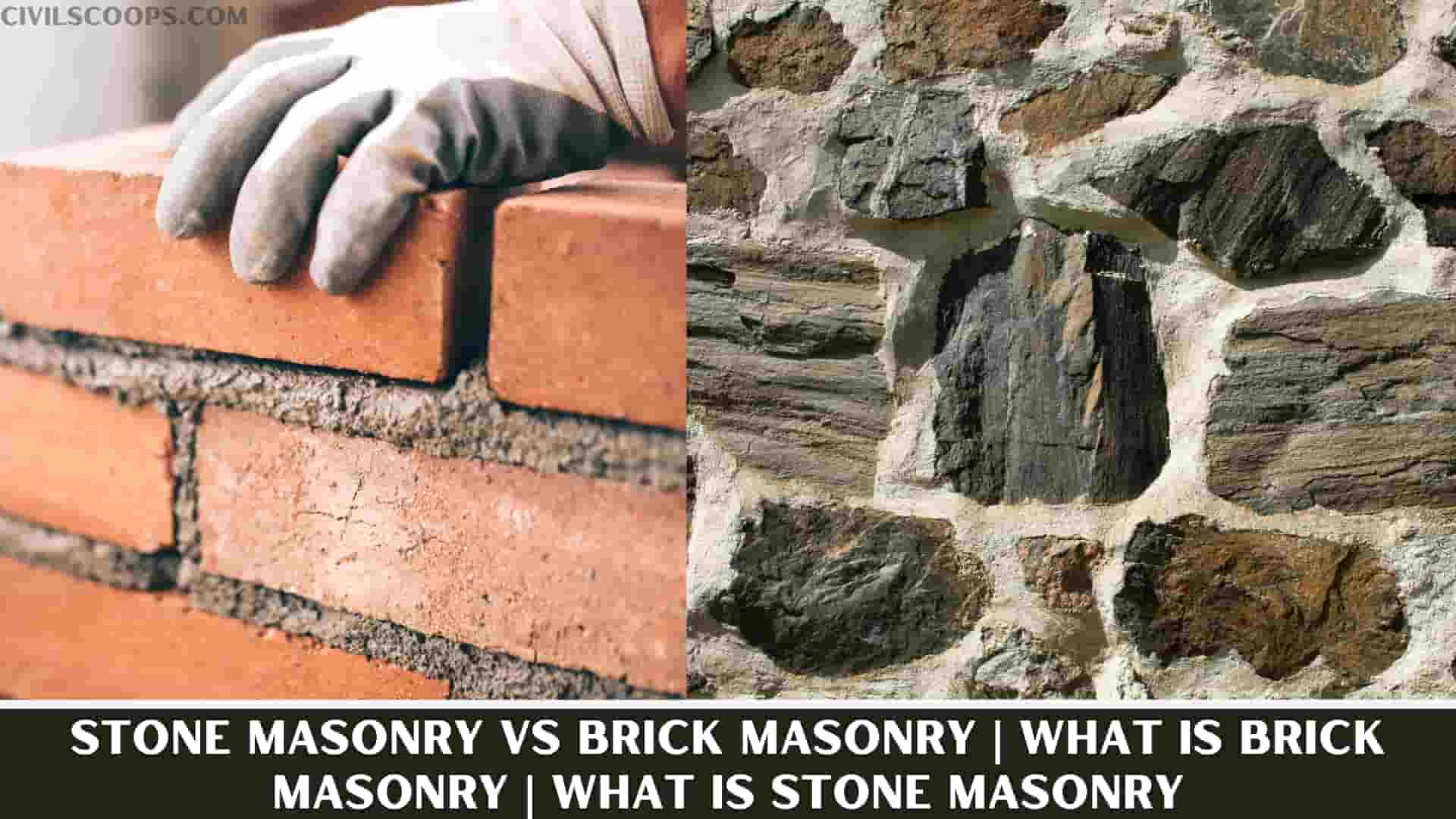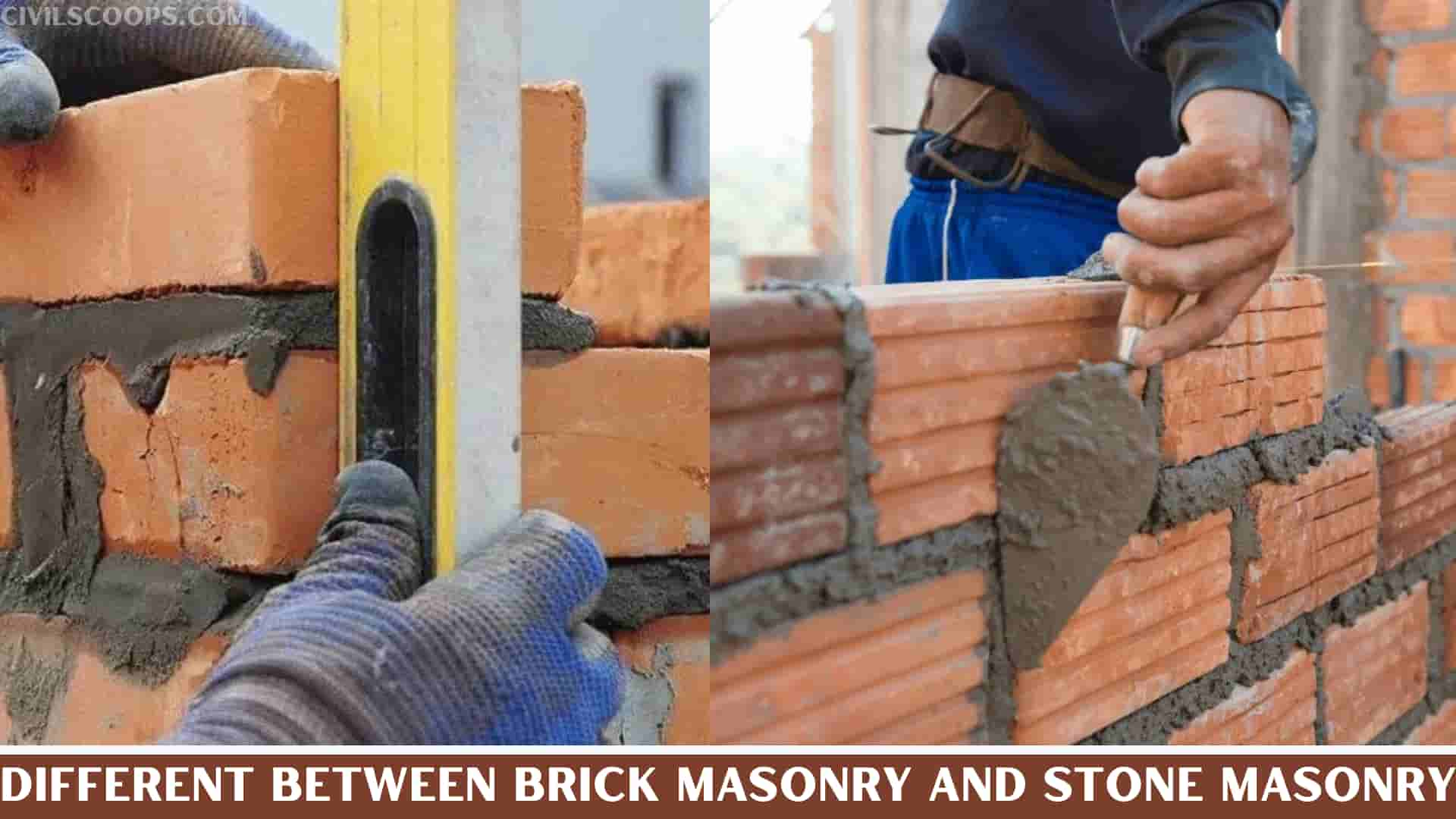Stone Masonry vs Brick Masonry | What Is Brick Masonry | What Is Stone Masonry

Table of Contents
What Is Brick Masonry?
It is constructed by placing the bricks in the mortar in an orderly manner to produce solid loads, which withstand excessive loads. There are a number of types of bricks and mortars that can be used to manufacture brick masonry.
Bonding in brick masonry, which adheres to bricks simultaneously, is constructed by filling the joints between the bricks with suitable mortar. Special precautions must be practiced since the mortar is mixed and placed as it greatly affects the performance and durability of the masonry structure.
What Is Stone Masonry?
The construction of stones bonded together with mortar is termed as stone masonry. Where the stones can be found in abundance in nature, on cutting and dressing to the proper shape, they provide an economical material for the construction of various building components such as walls, columns, tootings, arches, beams, etc..
Stone-masonry being stronger, durable, and weather-resistant, when compared with brick masonry, is used in the construction of piers, docks, dams lighthouse, and other marine structures.
Different Between Brick Masonry and Stone Masonry

15 differences between brick masonry and stone masonry are as follows.
1. Brick Masonry Vs Stone Masonry: Uses
Brick Masonry: Brick masonry uses in residential buildings
Stone Masonry: Stone masonry uses in Construction of piers, dams, docks, marine structures, residental and monumental buildings.
2. Brick Masonry Vs Stone Masonry: Strength
Brick Masonry: Brick masonry strength much less compared to stone masonry.
Stone Masonry: Stone masonry high crushing strength compared to brick masonry.
3. Brick Masonry Vs Stone Masonry: Durability
Brick Masonry: Brick masonry durability is excellent.
Stone Masonry: Also excellent stone masonry.
4. Brick Masonry Vs Stone Masonry: Source
Brick Masonry: Bricks are man-made products.
Stone Masonry: Here, Stones are natural products.
5. Brick Masonry Vs Stone Masonry: Danger from Dampness
Brick Masonry: Bricks are of an absorbent nature and no absorbing moisture make the buildings damp
Stone Masonry: Stones are less adsorbent, and hence stone masonry walls or buildings are more damp proof.
Also Read: Civil Engineering Basic Knowledge
6. Brick Masonry Vs Stone Masonry: Aesthetic
Brick Masonry: Bricks are (usually) made up of clay that is pressed into perfectly shaped molds, creating a completely uniform, classic look. They stack easily on top of each other and connected with mortar to form perfectly solid walls. Because of this, brick has much less flexibility regarding shape differences and color variety.
Stone Masonry: Stone tends to be less uniform in shape and size and boasts considerably more variety than bricks offer. Whether quarried or manufactured, stone offers more options for size, shape, and color than brick – however, if you’re looking for a completely uniform look, brick will evoke uniformity better than stone will. If you are looking to create a more modern, creative, or artistic aesthetic, stone opens a world of possibilities.
7. Brick Masonry Vs Stone Masonry: Fire-Resistant
Brick Masonry: They are good fire-resistant than stone.
Stone Masonry: They are not good fire-resistant than brickwork.
8. Brick Masonry Vs Stone Masonry: Cost
Brick Masonry: The cost of construction of brickwork is less.
Stone Masonry: The cost of construction of stonework is more than brickwork.
9. Brick Masonry Vs Stone Masonry: Shape
Brick Masonry: They are of uniform shape and size.
Stone Masonry: They are not of uniform in shape and size.
Also Read: Difference Between Heartwood and Sapwood | What Is Sapwood | What Is Heartwood
10. Brick Masonry Vs Stone Masonry: Availability
Brick Masonry: Bricks are easily available.
Stone Masonry: Stones are not easily available.
11. Brick Masonry Vs Stone Masonry: Appearance
Brick Masonry: Quality brick as facing in Flemish bond (without any external plastering) offers good apperarancel. But, generally both internal and external plastering is done over which decorative coating is given for better appearance.
Stone Masonry: Well textured and colour stone capable of taking polish improves its appearance. No treatment is required for improving appearance.
12. Brick Masonry Vs Stone Masonry: Bonding
Brick Masonry: Quick bonding is possible due to regular size and shape of brick and edges.
Stone Masonry: It requires more times and skilled labour for dressing stone and maintain proper bond.
13. Brick Masonry Vs Stone Masonry: Skilled Supervision
Brick Masonry: Skilled supervision may not be required as no dressing is needed and always an even bed present for construction.
Stone Masonry: High-skilled supervion required for dressing and binding.
14. Brick Masonry Vs Stone Masonry: Limitation In Uses
Brick Masonry: It isconveniently used in any locality due to local manufacturing of bricks.
Stone Masonry: The use of stone masonry is only restricted to hilly area due ti high cost of transoportation.
Also Read: Difference Between Mat Foundation and Spread Footing | What Is Mat Footing | What Is Spread Footing
15. Brick Masonry Vs Stone Masonry: Minimum Thickness of Wall
Brick Masonry: Minimum Thick of Brick Masonry wall is about 100 mm.
Stone Masonry: Minimum Thick of Stone Masonry wall is about 300 mm.
[su_box title=”FAQ” style=”default” box_color=”#333333″ title_color=”#FFFFFF” radius=”3″ class=”” id=””]
Brick Masonry Vs Stone Masonry
Stone tends to be less uniform in shape and size and boasts considerably more variety than bricks offer. Whether quarried or manufactured, stone offers more options for size, shape, and color than brick – however, if you’re looking for a completely uniform look, brick will evoke the uniformity better than stone will.
Difference Between Brick Masonry and Stone Masonry
Brick masonry is that in which bricks are used while in stone masonry, stone blocks are used. Generally brick masonry is cheaper than stone masonry and can be easily constructed. Brick masonry requires less mortar whereas stone masonry requires more mortar which cannot be easily estimated.
Brick vs Stone
While both materials are durable, stone is stronger than brick. But brick is less expensive than stone. Both can withstand the elements, including strong winds, hot sun, and sub-freezing temperatures.
What Is Masonry Work?
Masonry is a construction method that uses individual units, like brick and stone, bound together with mortar. It is one of the most durable construction techniques in the world, and it has been popular for centuries.
Stone Masonry Construction
Stone masonry refers to the shaping of rough pieces of rock into accurate geometrical shapes and then arranging the resulting stones together using mortar to form structures. The basic tools used by stonemasons consist of a metal straight edge, mallet, and chisels.
Stone Masonry Vs Brick Masonry
While both materials are durable, the stone is stronger than brick. But brick is less expensive than stone. Both can withstand the elements, including strong winds, hot sun, and sub-freezing temperatures.
Stone Masonry
What is stone masonry? Stonemasonry is essentially a type of construction technique that uses stones as the main material. Stones are cut, shaped, and placed to form structures and designs. Masons use them together with mortar to build foundations, walls, floors, and columns.
Ashlar Stone Masonry
Ashlar is a finely dressed stone, either an individual stone that has been worked until squared or a structure built from such stones. Ashlar is the finest stone masonry unit, generally rectangular cuboid, mentioned by Vitruvius as opus isodomum, or less frequently trapezoidal.
Stone Masonry Wall
What is stone masonry? Stonemasonry is essentially a type of construction technique that uses stones as the main material. Stones are cut, shaped, and placed to form structures and designs. Masons use them together with mortar to build foundations, walls, floors, and columns.
Cast Stone Masonry
Cast stone masonry is a refined architectural concrete building unit, manufactured to mimic natural cut stone and used in unit masonry applications. Cast stone can be made from white and/or grey cement, manufactured or natural sands, carefully selected crushed stone, or well-graded natural gravels.
Stonework Masonry
Stonemasonry or stonecraft is the creation of buildings, structures, and sculptures using stone as the primary material. It is one of the oldest activities and professions in human history.
Laterite Stone Masonry
Laterite stone blocks are being used as masonry material for housing construction in the Malabar region of western India for ages, because of being abundant, relatively easy to cut and shape and show good performance in many applications.
Medieval Stone Mason
There were three main classes of stonemasons. They were the apprentice, journeymen and the master mason. At a cathedral construction site, the master mason is usually the head and he oversees the work of all skilled and unskilled laborers.
[/su_box]
[su_note note_color=”#F2F2F2 ” text_color=”#333333″ radius=”3″ class=”” id=””]
Like this post? Share it with your friends!
Suggested Read –
- What Is Weirs | Types of Weirs | Advantages & Disadvantages of Weirs | Operation & Limitations For Weir | Limitations of Weirs | Location of Weirs
- What Is Sealing Brick Work| Advantages of Brick Sealer | Types of Brick Sealer
- 15 Different Types of Cement and Their Uses
- 10 Different Between Mortar And Concrete | What Is Mortar & Concrete | Types of Mortar & Concrete
- What Are the Components of Stairs | 19 Different Types of Stairs Components
[/su_note]
Originally posted 2022-09-08 13:08:40.
